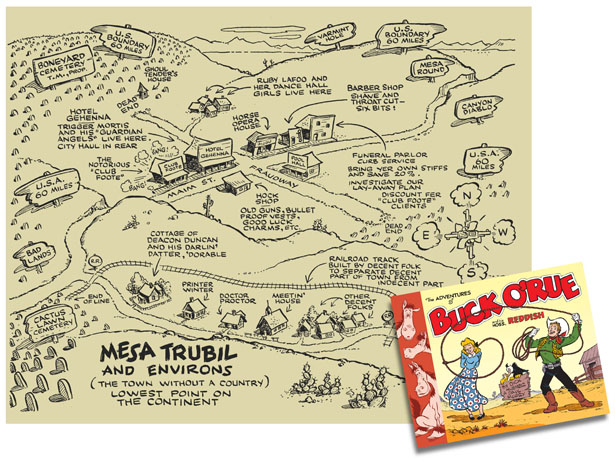
It’s a time-honored American tradition, fathers and sons going out to a ballgame, cheering for the home team, buying some peanuts and Cracker Jack. But few dads are as adventurous and driven as Mike Luery ’77, who undertook a 16-year odyssey to visit every Major League Baseball stadium in North America with his son, Matt. During that baseball pilgrimage, Luery would see his son go from boyhood to adulthood, passing through the turbulence of adolescence on the main part of the journey. It was a rite of passage that sorely tested their relationship and could have easily ended in disaster.
“You know, it can be difficult being trapped in a hotel room for a week with a teenager,” says Luery, with stunning understatement. “I just thought as he got older, what better way for a father and son to bond than to be on the road, and have baseball as our map?”
Luery, an award-winning TV news investigative journalist who has taken on the Ku Klux Klan and exposed cocaine abuse, retells the father-son saga in his recent book, Baseball Between Us. In honest but sometimes unsparing detail, Luery lays bare the generational tensions and personality clashes between two opinionated travelers, one a compulsive and fastidious planner who dreaded being late for the first pitch, the other a free spirit who would risk missing a flight if he could just sleep in a little longer. Most parents with teenagers might have balked at the idea from the start. In the words of the great Yogi Berra: “You’ve got to be very careful if you don’t know where you are going because you might not get there.”
B ut Luery can be a “stubborn cuss,” as a friend bluntly puts it. For him, love of family and love of baseball are inextricably linked. Baseball is not just a pastime, it’s a legacy—one that he inherited from his own father and “baseball buddy,” Robert Luery, who took him to the World Series at Yankee Stadium in 1963 when he was 8. Sure, the Dodgers with Sandy Koufax on the mound swept the Yankees that year, and little Mike cried all the way home, but baseball had gotten in his blood.
ut Luery can be a “stubborn cuss,” as a friend bluntly puts it. For him, love of family and love of baseball are inextricably linked. Baseball is not just a pastime, it’s a legacy—one that he inherited from his own father and “baseball buddy,” Robert Luery, who took him to the World Series at Yankee Stadium in 1963 when he was 8. Sure, the Dodgers with Sandy Koufax on the mound swept the Yankees that year, and little Mike cried all the way home, but baseball had gotten in his blood.
Once he became a father, he wanted his boy to share the passion, but the conversion would not be so magical. The first time he took his family to a ballgame was an admitted flop. It was 1994, to see the St. Louis Cardinals at Busch Stadium. The kids, Matt, 5, and his older sister Sarah, 8, were tired and hungry; his wife, Carol, was bored. Yet, the irrepressible Mr. Luery vowed to take his reluctant brood to a ballgame in every city they visited.
Luery became Matt’s Little League coach and continued taking him to games as a boy. In 2005, when Matt was 16, they embarked on their baseball expedition in earnest. Their mission: to visit parks and places they had never been to before. That year, the duo started out from their hometown in Sacramento, where Luery is a reporter for the NBC affiliate KCRA-TV, and flew to Detroit to watch the Tigers trounce the San Francisco Giants on a warm night at Comerica Park. There was no turning back.
To no parents’ surprise, the trip confirmed that teenagers excel at sulking, sleeping and scoffing at their elders. (Informed that Wrigley Field was built in 1914, Matt says, “Wow, Dad, that’s even older than you are.”) Luery and his son argued over almost everything: politics, history and especially what music to play on long car rides, classic rock versus rap. (“Dad, I’m tired of listening to all those dead guys.”) All along the way, Matt chafed at being used as a “prop” for another in his father’s endless series of snapshots. “By taking a picture,” the teen declared, “you are altering the authenticity of the moment.”
The pair also managed to share some good times. Matt, who graduated last year from USC with a degree in architecture, appreciated the design and urban planning of the stadiums. (Target Field in Minnesota gets high marks because “you don’t need a car to get there.”) And the teenager was thoroughly charmed by a chance meeting with former Dodger great Maury Wills.
 In the end, father and son grew closer, and wiser. Matt learned to savor the slow pace of baseball games and really admire Jimi Hendrix. (“Dad, you may be a dinosaur but you rock.”) And Mike learned to be more flexible as a father, less quick to condemn, more willing to accept the differences between generations. From his son, he learned the “value of serendipity,” of going places without a compass, doing things without a blueprint: “Dad, the beauty of the trip is sometimes you get lost and you end up in a better place.”
In the end, father and son grew closer, and wiser. Matt learned to savor the slow pace of baseball games and really admire Jimi Hendrix. (“Dad, you may be a dinosaur but you rock.”) And Mike learned to be more flexible as a father, less quick to condemn, more willing to accept the differences between generations. From his son, he learned the “value of serendipity,” of going places without a compass, doing things without a blueprint: “Dad, the beauty of the trip is sometimes you get lost and you end up in a better place.”
The final stats: 16 years, 32 ballparks, 43,000 miles. Matt Luery, now 24, is grateful for all the time he and his dad spent together, even if they had disagreements “every now and then.” That’s what he wrote in a loving epilogue to his father’s book which, in the end, earned its positive subtitle: “A Roadmap to a Winning Father/Son Relationship.”
One of the most moving moments of the trip had nothing to do with baseball, directly. Luery was anxious for his son to see his childhood haunts in Stamford, Conn., a prosperous suburb about 30 miles from Manhattan. He was devastated to find his old home turned into a “foreclosure rat-trap,” boarded up and vandalized.
Later, his dismay deepened when visiting the gravesite of his sister, who had died at age 20 in a car crash. It was overgrown with weeds and crusted with dirt. The hard-charging, fast-talking reporter was reduced to tears, down on his knees, trying vainly to restore his sister’s nameplate. Matt instinctively moved to comfort his father, with reassuring words and a gentle hand on the shoulder. For once, the child was father to the man. Then they got back on the road to Shea Stadium, where that night the father and son watched the Mets shut out the Marlins, 3-0.
“For me, baseball has always been the fabric that holds us together,” says Mike, who got his start in broadcasting as a deejay at KSPC. “No matter how bad of a day you had, no matter what happened in the world, no matter how many losses, you always had comfort in baseball.”
Mike Luery’s Top 10 Ballparks
1) AT&T Park, San Francisco Giants Splash hits into the beautiful bay.
2) PNC Park, Pittsburgh Pirates Take a water taxi to the game.
3) Fenway Park, Boston Red Sox Tradition runs deep.
4) Oriole Park, Baltimore Orioles Enjoy barbecue at ex-player Boog Powell’s eatery.
5) Comerica Park, Detroit Tigers Life-size outfield replicas of Cobb, Kaline and Horton.
6) Target Field, Minnesota Twins Take light rail from airport to the park.
7) Coors Field (Denver), Colorado Rockies Great view of the Rocky Mountains.
8)Busch Stadium, St. Louis Cardinals The Gateway Arch makes an awesome backdrop.
9) Citizens Bank Park, Philadelphia Phillies Take the subway with the fanatic fans.
10) Progressive Field, Cleveland Indians Park filled with monuments to legendary players.




 Statistics always have been important in baseball, but in recent decades the familiar stats such as batting average, ERA (earned-run average) and RBI (runs batted in) have been supplemented by an alphabet soup of acronyms, all trying to quantify aspects of the game. There’s WHIP (walks and hits per inning pitched) WAR (wins above replacement) BABIP (batting average on balls in play) and FIP (fielding-independent pitching) and those are just some of the more well-known ones.
Statistics always have been important in baseball, but in recent decades the familiar stats such as batting average, ERA (earned-run average) and RBI (runs batted in) have been supplemented by an alphabet soup of acronyms, all trying to quantify aspects of the game. There’s WHIP (walks and hits per inning pitched) WAR (wins above replacement) BABIP (batting average on balls in play) and FIP (fielding-independent pitching) and those are just some of the more well-known ones.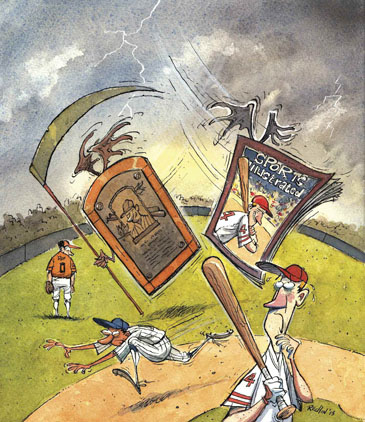 In his paper, “The Baseball Hall of Fame is Not the Kiss of Death,” Smith has debunked research that purported to show getting into Cooperstown would shorten a player’s life expectancy. He also has taken apart a study that suggested major league players with names that start with “D” die younger than others. (Derek Jeter really should send Smith a fruit basket.) Ditto for another piece of research that concluded players with negative initials (think ASS) die younger than players with positive initials (think ACE).
In his paper, “The Baseball Hall of Fame is Not the Kiss of Death,” Smith has debunked research that purported to show getting into Cooperstown would shorten a player’s life expectancy. He also has taken apart a study that suggested major league players with names that start with “D” die younger than others. (Derek Jeter really should send Smith a fruit basket.) Ditto for another piece of research that concluded players with negative initials (think ASS) die younger than players with positive initials (think ACE).


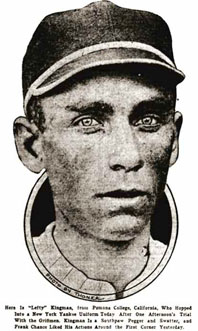 “We are all deeply indebted to Harry Kingman—such men are almost unique,” wrote Earl Warren, during his time as chief justice of the U.S. Supreme Court. “Few have given so much of their lives to ensure man’s birthright of equality and liberty.”
“We are all deeply indebted to Harry Kingman—such men are almost unique,” wrote Earl Warren, during his time as chief justice of the U.S. Supreme Court. “Few have given so much of their lives to ensure man’s birthright of equality and liberty.” In his baseball-loving boyhood, Don Daglow ’74 used to get calluses on his fingers from flicking the spinner for the All-Star Baseball board game that he’d play again and again, sometimes eight times a day. Over time, he even reworked the venerable game to allow changes in pitching.
In his baseball-loving boyhood, Don Daglow ’74 used to get calluses on his fingers from flicking the spinner for the All-Star Baseball board game that he’d play again and again, sometimes eight times a day. Over time, he even reworked the venerable game to allow changes in pitching.
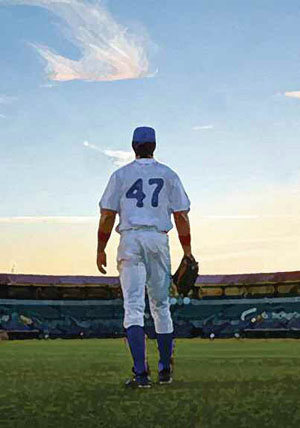

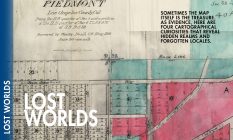

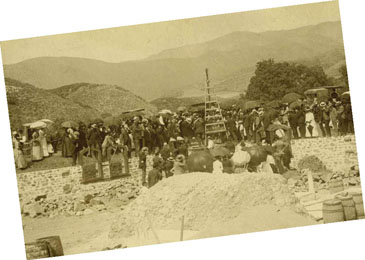 There remained, however, a photo from the September day in 1888 when hundreds of people gathered at the base of the foothills north of Pomona for the cornerstone ceremony. That old black and white helped lead me back to the spot known as Piedmont Mesa and its faint traces of the College’s beginnings.
There remained, however, a photo from the September day in 1888 when hundreds of people gathered at the base of the foothills north of Pomona for the cornerstone ceremony. That old black and white helped lead me back to the spot known as Piedmont Mesa and its faint traces of the College’s beginnings. Even on the little screen, it was easy to line up the old view with the present one, since the hills had changed so little in 125 years. Comparing the two views, it looked to us like the site of the original cornerstone—later relocated—might just lie beneath the 210 Freeway, which today slices through the site.
Even on the little screen, it was easy to line up the old view with the present one, since the hills had changed so little in 125 years. Comparing the two views, it looked to us like the site of the original cornerstone—later relocated—might just lie beneath the 210 Freeway, which today slices through the site.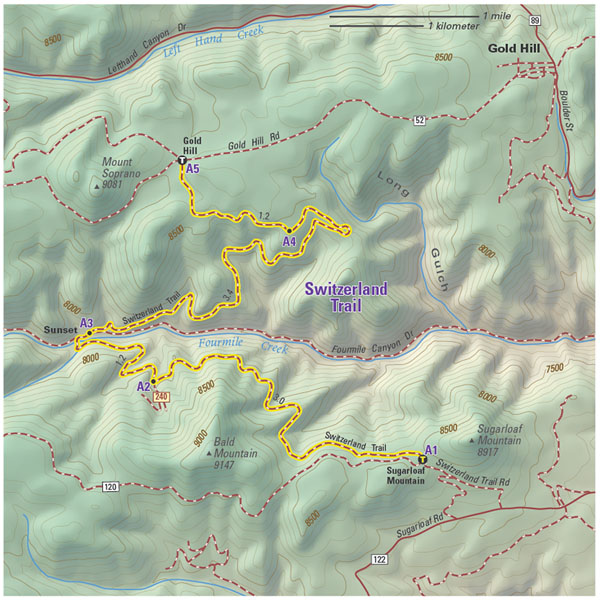
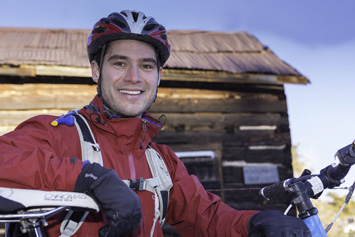
 Fortunately, he was able to include some of the historical tidbits—along with 118 maps—in his recently published book, The Mountain Biker’s Guide to Colorado (Fixed Pin Publishing). Hickstein is now a fourth-year grad student at University of Colorado, where he studies how ultrafast lasers can be used to make super-slow-motion movies of chemical reactions. But after a long day in the lab, Hickstein still finds time to ride the trails, sometimes even bringing along his own tome and its trusty maps.
Fortunately, he was able to include some of the historical tidbits—along with 118 maps—in his recently published book, The Mountain Biker’s Guide to Colorado (Fixed Pin Publishing). Hickstein is now a fourth-year grad student at University of Colorado, where he studies how ultrafast lasers can be used to make super-slow-motion movies of chemical reactions. But after a long day in the lab, Hickstein still finds time to ride the trails, sometimes even bringing along his own tome and its trusty maps.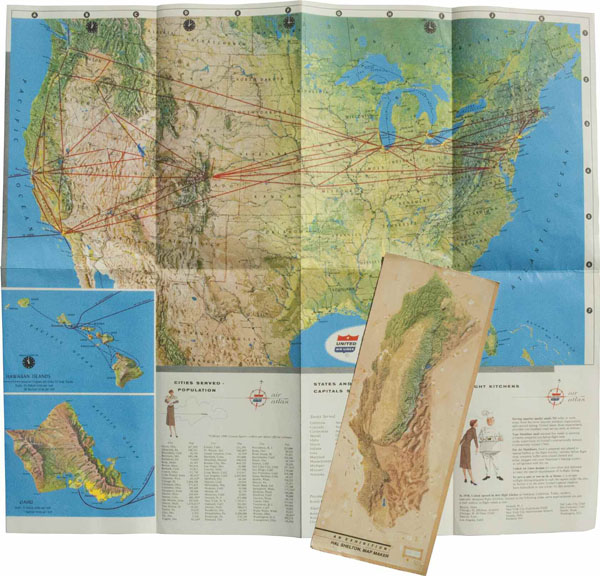
 If the natural color concept seems straightforward—forests are green, deserts are brown— the execution required patience, skill and considerable expense. Decades before satellite imagery was widely available, Jeppesen hired academic geographers to gather the data, which was etched into zinc plates about two to three feet in diameter. Working on an inch at a time, Shelton then painstakingly painted on the landscape features along with shaded relief to show elevation. His artistry yielded “realistic picture maps that astound the cartographic world,” as The New York Times gushed in 1954.
If the natural color concept seems straightforward—forests are green, deserts are brown— the execution required patience, skill and considerable expense. Decades before satellite imagery was widely available, Jeppesen hired academic geographers to gather the data, which was etched into zinc plates about two to three feet in diameter. Working on an inch at a time, Shelton then painstakingly painted on the landscape features along with shaded relief to show elevation. His artistry yielded “realistic picture maps that astound the cartographic world,” as The New York Times gushed in 1954.